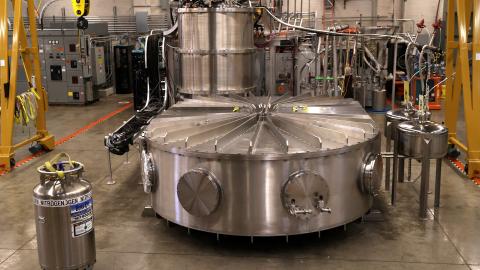American policymakers have spent years decrying the loss or impending loss of key competitive sectors to China, including 5G telecommunications networks, solar panels, advanced manufacturing, and quantum computing. Recently, it was reported that China was outspending the United States on fusion energy and that it could surpass U.S. fusion capabilities in three to four years. The United States can’t let this happen.
Fusion will provide reliable, carbon-free electricity for an expanding global economy. That will have profound geopolitical consequences. If we allow China to dominate fusion technology and to deploy it at scale at home and abroad, Beijing will hold a central position in the geopolitics of energy going forward.
Fusion occurs when two atoms combine into one, releasing astronomical amounts of energy. Some new fusion designs produce superheated plasma that can reach temperatures of up to 100 million degrees Celsius, producing energy with minimal radiation risks.
For generations, fusion has been the stuff of science fiction because of the challenge of recreating the physics of the sun in a controlled environment on earth. But in the last few years, scientists and engineers, working on competing models for producing fusion, have made transformational progress on several classes of daunting problems, faster than the public perceives. And faster than U.S. policy is reflecting.
Just as important as the physics behind these milestones are the advances in key “adjacent technologies” that help to manage the hot plasma at the heart of all fusion reactions. Advances in fiber optics, semiconductors, and computing, including AI, have been critical to progress. Power semiconductors have allowed the introduction of different fusion architectures, creating more opportunities and faster progress. Advanced fiber optics mean we don’t have to worry about electromagnetic interference. Powerful computers allow this intricate atomic ballet to be choreographed and repeated thousands of times per second.
Thanks to American innovation and determination, the fusion moment is here. When matched with private sector investment, it’s a potent force. But we could lose this moment to China unless the U.S. government takes steps now to accelerate manufacturing at scale and deployment.
First, fusion must be considered a considered a key part of the shift to clean energy. The focus for years has been almost exclusively on renewable solar and wind – which cannot solve the problem of intermittent energy. A Department of Energy report in 2022 advanced a U.S. strategy to secure supply chains for “Robust Clean Energy Transition” without mentioning fusion. The Biden Administration’s “Decadal Vision” for commercial fusion was a corrective, but fusion will need wider acceptance to take its place in the world’s energy mix.
Second, the U.S. government must create a regulatory environment that differentiates modern fusion technology from 20th century nuclear energy and that allows for scaled deployment. The Nuclear Regulatory Commission – which controls matters related to fission and fusion energy – has taken some important first steps. In April 2023, for example, it acknowledged that fusion energy should be treated as a technology separate from nuclear fission. Notably, the U.K. government also ruled on the “fundamental differences between nuclear fission and fusion” and that it would be “unnecessary to incorporate fusion energy facilities into nuclear regulation.” These are key steps toward a regulatory structure that would allow U.S. companies to produce fusion generators at scale. We can’t afford to wait 10 years to plan for power plants to come on-line. Just as our airline industry produces scores of airplane designs without having to separately approve each plane, U.S. fusion companies need to be able to manufacture generators in a repeatable way in large-scale factories to be effective.
Deploying fusion generators at scale will have the added benefit of catalyzing American manufacturing. But to achieve this, the U.S. needs to make the needed components. Most attention in the Act is focused on leading-edge microchips for computing – the kinds that are now primarily made in Taiwan. But it’s critical that the United States and its allies produce the kind of other semiconductors that enable the sophisticated physics synthesis required by fusion. Currently, a large majority of high-power semiconductor production and innovation takes place outside the United States.
Third, loan programs and tax incentives that apply to renewables need to be opened up to fusion. Currently for example, the production tax credit for manufacturing is geared towards renewables and does not include fusion. These programs and various Department of Energy efforts, while well-funded, need to prioritize fusion.
In the 19th century, the great powers scrambled to develop technology and secure petroleum supplies around the globe to ensure a secure foothold in the energy future. Today, a similar scramble is unfolding. Electrification for economic growth coupled with the new energy requirements of generative AI – which are immense – together will have critical geostrategic consequences. Beijing recognizes that fusion is a source of near-unlimited energy and that achieving it at scale will not only give China the energy independence it craves but also a leading position as supplier of these new sources of energy around the world.
Fusion is a moonshot opportunity. We can’t afford to miss it.
Read this article, co-authored with Craig Mundie, in RealClearDefense.
Enjoyed this article? Subscribe to Hudson’s newsletters to stay up to date with our latest content.


















